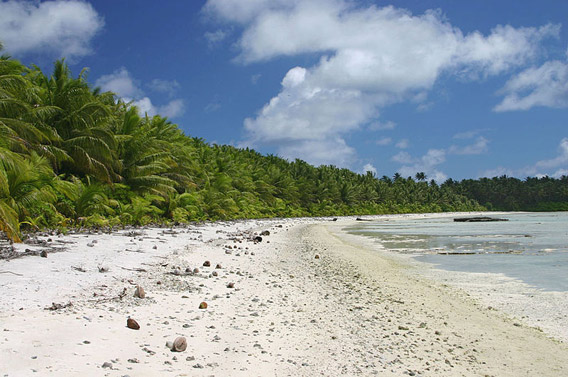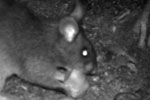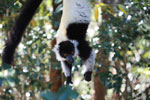
Beach on Palmyra Atoll.
Ecologists have long argued that everything in the nature is connected, but teasing out these intricate connections is not so easy. In fact, it took research on a remote, unoccupied island for scientists to discover that manta ray abundance was linked to seabirds and thereby native trees.
Working in the U.S. owned Palmyra Atoll, deep in the Pacific Ocean, three scientists discovered an ecological chain stretching from treetops to deep waters. The atoll is an important roosting site for many seabirds. With so many birds roosting, bird droppings piled up in the soil, enriching it with nutrients, and when the tide rose those nutrients were washed out into adjacent waters. The nutrient-rich waters allowed abundant plankton populations to thrive, which in turn attracted manta rays to forage the waters near Palmyra Atoll.
At least, that’s how it should be. Cataloging this long string of connections, the researchers also recorded its disturbance: growing non-native palm trees on the island was leading to a decline in birds. The scientists recorded that when palm trees replaced native species it resulted in about five times fewer seabirds stopping to roost: less birds means less droppings, less nutrients, less plankton, and less mantra rays.
Not only did the research document an unrivaled ecological chain, it also showed how easily such hidden chains could be broken by human activity.
“What we are doing in some ecosystems is akin to popping the hood on a car and disconnecting a few wires and rerouting a few hoses. All the parts are still there—the engine looks largely the same—but it’s anyone’s guess as to how or if the car will run,” one of the researchers, Douglas McCauley, explained in a press release.
Related articles
New meteorological theory argues that the world’s forests are rainmakers

(02/01/2012) New, radical theories in science often take time to be accepted, especially those that directly challenge longstanding ideas, contemporary policy or cultural norms. The fact that the Earth revolves around the sun, and not vice-versa, took centuries to gain widespread scientific and public acceptance. While Darwin’s theory of evolution was quickly grasped by biologists, portions of the public today, especially in places like the U.S., still disbelieve. Currently, the near total consensus by climatologists that human activities are warming the Earth continues to be challenged by outsiders. Whether or not the biotic pump theory will one day fall into this grouping remains to be seen. First published in 2007 by two Russian physicists, Victor Gorshkov and Anastassia Makarieva, the still little-known biotic pump theory postulates that forests are the driving force behind precipitation over land masses.
Protecting original wetlands far preferable to restoration
(01/26/2012) Even after 100 years have passed a restored wetland may not reach the state of its former glory. A new study in the open access journal PLoS Biology finds that restored wetlands may take centuries to recover the biodiversity and carbon sequestration of original wetlands, if they ever do. The study questions laws, such as in the U.S., which allow the destruction of an original wetland so long as a similar wetland is restored elsewhere.
Giant rat plays big ecological role in dispersing seeds

(11/16/2011) Rats are rarely thought of as heroes. In fact, in many parts of the world they are despised, while in others they serve largely as food. But, scientists are now discovering that many tropical forest rodents, including rats, serve as heroic seed dispersers, i.e. eating fruits and nuts, and carrying seeds far from the parent tree, giving a chance to a new sapling. While this has been documented with tropical rodents in South America like agoutis and acouchis, a new study in Biotropica documents the first successful seed dispersal by an African rodent: the Kivu giant pouched rat (Cricetomys kivuensis), one of four species of giant African rats.
Critically Endangered lemurs disperse seeds, store carbon

(11/13/2011) Many tropical plants depend on other species to carry their progeny far-and-wide. Scientists are just beginning to unravel this phenomenon, known as seed dispersal, which is instrumental in supporting the diversity and richness of tropical forests. Researchers have identified a number of animal seed dispersers including birds, rodents, monkeys, elephants, and even fish. Now a new study in the Journal of Tropical Ecology adds another seed disperser to that list: the Critically Endangered black-and-white ruffed lemur (Varecia variegata). Capable of dispersing big tree species, the black-and-white ruffed lemur may even play a big role in carbon sequestration.